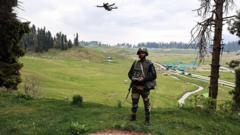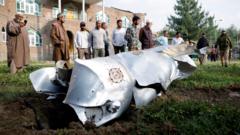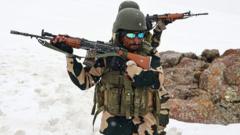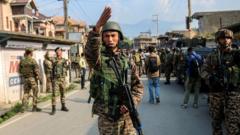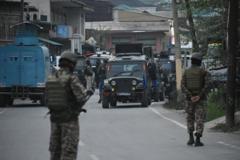In the wake of increasing hostilities between India and Pakistan, the Indian government has ordered a nationwide set of civil defense drills to ensure preparedness for a possible military engagement. This directive comes as a direct response to heightened tensions sparked by a recent attack that claimed the lives of 26 individuals in the disputed Kashmir region, an area both nations stake their claims over.
India Prepares for Potential Military Conflict as Tensions with Pakistan Rise

India Prepares for Potential Military Conflict as Tensions with Pakistan Rise
India's government initiates civil defense drills amid escalating tensions following a tragic attack in Kashmir.
The conflict has its roots deeply embedded in the historical animosity between the two nuclear-armed countries, which have engaged in multiple wars over Kashmir. India has attributed the recent terrorist attack to Pakistan, which Islamabad denies vehemently. In response, India's leadership has been vocal about the necessity for military action against perceived sanctuaries for terrorist organizations within Pakistani territory. Pakistan has countered this by asserting its readiness to respond to any military interventions from India.
The situation has escalated in recent weeks, with instances of small-arms fire exchanged along the border. Notably, Indian Prime Minister Narendra Modi has held several strategy meetings with military officials, hinting at the possibility of an impending military strike.
To ensure civilian readiness, the Home Ministry of India dispatched a letter mandating drills in 244 designated civil defense districts—regions identified due to their proximity to borders or due to heightened risks associated with potential attacks. The drills will include practical exercises designed to test the capabilities of air raid sirens, instruct residents on managing power blackouts, and practice emergency evacuations.
Within the past few days, preparations have visibly ramped up in border areas, particularly Kashmir. Significant efforts are being made to educate the public; recent footage has surfaced showing schoolchildren participating in safety drills, including practicing the "duck and cover" technique and preparing bunkers for use during potential air raids.
As the situation continues to unfold, observers remain cautiously attuned to the developments, underpinning a critical juncture in the fraught relationship between the two nations. The stakes are undeniably high, with the potential for significant regional implications hanging in the balance.
The situation has escalated in recent weeks, with instances of small-arms fire exchanged along the border. Notably, Indian Prime Minister Narendra Modi has held several strategy meetings with military officials, hinting at the possibility of an impending military strike.
To ensure civilian readiness, the Home Ministry of India dispatched a letter mandating drills in 244 designated civil defense districts—regions identified due to their proximity to borders or due to heightened risks associated with potential attacks. The drills will include practical exercises designed to test the capabilities of air raid sirens, instruct residents on managing power blackouts, and practice emergency evacuations.
Within the past few days, preparations have visibly ramped up in border areas, particularly Kashmir. Significant efforts are being made to educate the public; recent footage has surfaced showing schoolchildren participating in safety drills, including practicing the "duck and cover" technique and preparing bunkers for use during potential air raids.
As the situation continues to unfold, observers remain cautiously attuned to the developments, underpinning a critical juncture in the fraught relationship between the two nations. The stakes are undeniably high, with the potential for significant regional implications hanging in the balance.

